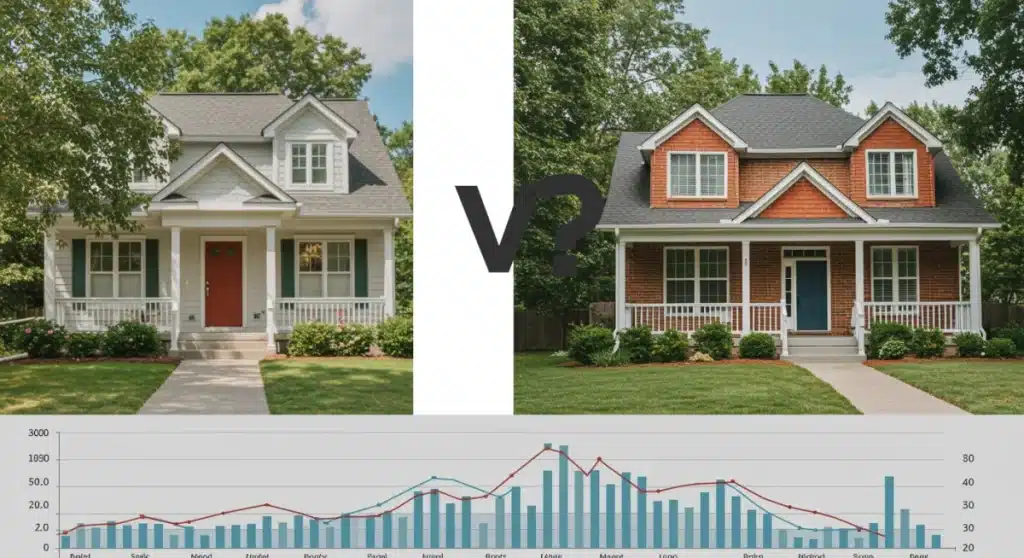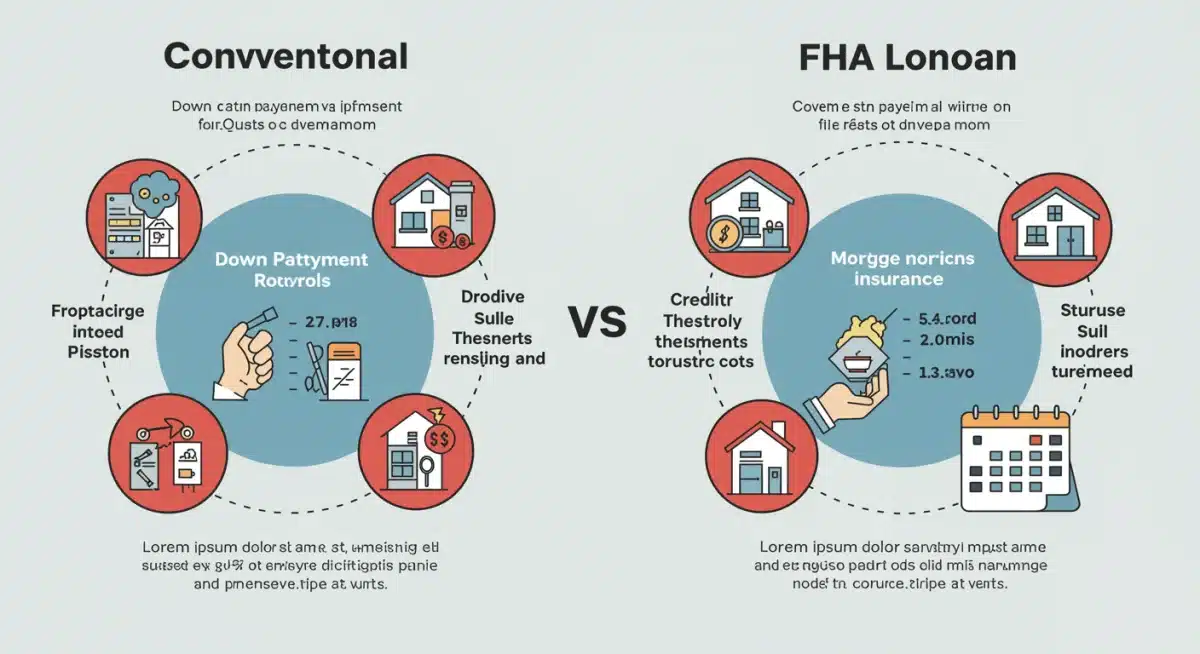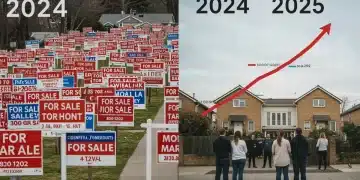Conventional vs. FHA 2025: 30-Year Fixed Rates Compared

As of late 2024, prospective homebuyers are keenly evaluating Conventional vs. FHA 2025 30-year fixed rates. Understanding the nuances of each loan type is crucial for securing the most favorable terms in a dynamic housing market.
With 2025 on the horizon, many aspiring homeowners are grappling with a critical decision: whether a Conventional Loan vs. FHA 2025 30-year fixed rate offers the better path to homeownership. This choice, influenced by evolving market conditions and individual financial profiles, demands careful consideration to secure the most advantageous financing.
Understanding Conventional Loans in 2025
Conventional loans, backed by private lenders without government insurance, remain a cornerstone of the mortgage market. For 2025, these loans are anticipated to appeal primarily to borrowers with strong credit histories and substantial down payments, offering competitive interest rates and flexible terms.
Recent developments suggest that as the economy stabilizes, conventional lenders may slightly ease some underwriting standards while still prioritizing low-risk applicants. This could translate to more accessible conventional financing for a broader segment of well-qualified buyers in the coming year.
Credit Score and Down Payment Expectations
For a conventional loan in 2025, credit score requirements are expected to hover around a minimum of 620, though scores above 700 will typically secure the best interest rates. Down payment expectations can vary significantly, ranging from as low as 3% for certain programs to the traditional 20% to avoid private mortgage insurance (PMI).
- Minimum Credit Score: Generally 620, but 700+ for optimal rates.
- Down Payment Range: 3% to 20% or more, depending on lender and program.
- PMI Avoidance: 20% down payment is key to bypassing private mortgage insurance.
- Debt-to-Income Ratio: Typically capped at 43-45%, though exceptions exist.
Private Mortgage Insurance (PMI) Nuances
Unlike FHA loans, conventional loans require PMI if the down payment is less than 20% of the home’s purchase price. This insurance protects the lender in case of default. However, a significant advantage of conventional loans is that PMI can often be canceled once sufficient equity is built in the home, typically when the loan-to-value (LTV) ratio reaches 80%.
The cost of PMI varies based on credit score, loan-to-value ratio, and other factors, usually ranging from 0.3% to 1.5% of the original loan amount annually. Understanding these costs is crucial when comparing the overall expense of a conventional loan versus an FHA loan, where mortgage insurance is typically a more permanent feature.
Exploring FHA Loans for 2025
FHA loans, insured by the Federal Housing Administration, are designed to make homeownership more accessible, particularly for first-time buyers or those with less-than-perfect credit. In 2025, these loans will continue to offer flexible underwriting criteria and lower down payment options, serving as a vital pathway for many.
The FHA’s role as a guarantor mitigates risk for lenders, allowing them to extend credit to borrowers who might not qualify for conventional financing. This government backing means FHA loans often have more lenient requirements for credit scores and debt-to-income ratios, making them an attractive option in a competitive market.
Credit and Down Payment Flexibility
One of the most significant advantages of an FHA loan is its flexibility regarding credit scores and down payments. For 2025, borrowers can typically qualify with a credit score as low as 580 with a 3.5% down payment. Those with credit scores between 500 and 579 may still qualify, albeit with a larger down payment of 10%.
This lower barrier to entry makes FHA loans particularly appealing for individuals who may have experienced financial setbacks or are just starting to build their credit history. The FHA’s focus is on ensuring homeownership opportunities, even if it means accepting slightly higher risk profiles compared to conventional lenders.
- Minimum Credit Score: 580 for 3.5% down; 500-579 for 10% down.
- Down Payment: As low as 3.5% of the purchase price.
- Debt-to-Income Ratio: Generally more flexible, up to 50% in some cases.
- Loan Limits: FHA loans have specific county-level loan limits that must be adhered to.
Mortgage Insurance Premiums (MIP)
A key component of FHA loans is the mandatory Mortgage Insurance Premium (MIP). This includes an upfront MIP (UFMIP) and an annual MIP. For 2025, the UFMIP is typically 1.75% of the loan amount, paid at closing or financed into the loan. The annual MIP varies but is usually around 0.55% of the loan balance, paid monthly.
Unlike conventional PMI, FHA’s annual MIP is generally required for the life of the loan if the initial down payment was less than 10%. If the down payment was 10% or more, the MIP can be canceled after 11 years. This distinction in mortgage insurance costs and duration is a critical factor when comparing the long-term affordability of FHA versus conventional loans.
30-Year Fixed Rates: What to Expect in 2025
The 30-year fixed-rate mortgage remains the most popular choice for homebuyers due to its predictable monthly payments and long-term stability. For 2025, experts anticipate a relatively stable, though potentially fluctuating, interest rate environment, influenced by global economic factors and domestic monetary policy.
Current projections, as of late 2024, suggest that while rates may not return to the historic lows seen a few years ago, they are unlikely to see dramatic increases. Borrowers should monitor economic indicators closely, as even small shifts can impact monthly payments on a 30-year fixed loan.
Factors Influencing 2025 Rates
Several key factors will influence 30-year fixed rates in 2025. Inflation, the Federal Reserve’s interest rate policies, and the overall strength of the housing market will play significant roles. A strong economy typically leads to higher rates, while economic slowdowns can prompt rate cuts.
Geopolitical events and global financial stability also contribute to rate volatility. Mortgage-backed securities (MBS) yields, which are directly tied to mortgage rates, react to these broader market forces. Staying informed about these influences can help prospective buyers anticipate rate movements.
- Inflation Trends: Persistent inflation often leads to higher interest rates.
- Federal Reserve Policy: Fed rate hikes or cuts directly impact borrowing costs.
- Economic Growth: A robust economy can drive rates higher.
- Housing Market Demand: High demand can sometimes put upward pressure on rates.
Rate Comparison: Conventional vs. FHA
Historically, FHA loans have often offered slightly lower interest rates than conventional loans, primarily because of the government insurance backing. However, this is frequently offset by the mandatory mortgage insurance premiums associated with FHA loans, which can make the overall monthly payment higher.
In 2025, this trend is expected to largely continue. While the nominal interest rate on an FHA loan might appear attractive, it is crucial to factor in the total cost, including all mortgage insurance. Conventional loans, despite potentially higher initial rates for some, can become more cost-effective over time, especially if PMI can be canceled.
Eligibility Requirements: A Closer Look
Understanding the specific eligibility requirements for both conventional and FHA loans is paramount before applying. While both aim to facilitate homeownership, their criteria reflect different risk appetites and policy objectives. Aligning your financial profile with the right loan type is key to a smooth approval process for 2025.
Beyond credit scores and down payments, other factors such as employment history, debt-to-income ratios, and property condition also play a significant role. Lenders will thoroughly review these aspects to assess a borrower’s ability to repay the loan, making comprehensive preparation essential.
Conventional Loan Eligibility
Conventional loan eligibility typically demands a more robust financial standing. Lenders look for stable employment, a consistent income stream, and a low debt-to-income (DTI) ratio. While a 620 credit score is often the minimum, a higher score significantly improves terms.
The property itself must also meet certain standards, though these are generally less stringent than FHA requirements. Appraisals for conventional loans focus on market value and structural integrity, ensuring the property is a sound investment for both borrower and lender.
- Stable Employment: Typically 2+ years in the same field.
- Income Verification: Consistent and verifiable income sources.
- Debt-to-Income Ratio: Generally below 45% for optimal approval.
- Property Condition: Must meet general safety and soundness standards.
FHA Loan Eligibility
FHA loan eligibility is designed to be more inclusive. While a stable income and employment history are still important, the FHA is more forgiving of past credit issues. The lower credit score requirements and flexible DTI limits open doors for many who might otherwise be excluded from the conventional market.
However, FHA loans have specific property standards. Homes must meet certain health and safety requirements, which can sometimes lead to additional repairs or considerations during the appraisal process. This is to protect both the borrower and the FHA’s insurance fund.
The FHA also has specific loan limits, which vary by county and are updated annually. Borrowers must ensure the home they intend to purchase falls within these limits to qualify for FHA financing in 2025. These limits are designed to support affordable housing in various markets across the country.
The Impact of Mortgage Insurance
Mortgage insurance is a critical component of both conventional and FHA loans, but its structure and implications differ significantly. Understanding these differences is vital for a clear comparison of the total cost of homeownership. For 2025, these insurance aspects continue to be a major differentiator between the two loan types.
While both private mortgage insurance (PMI) for conventional loans and Mortgage Insurance Premiums (MIP) for FHA loans serve to protect the lender, their impact on a borrower’s long-term financial picture can be quite distinct. This requires careful calculation and consideration based on individual financial goals.
Conventional Loan’s PMI Dynamics
Private Mortgage Insurance (PMI) on conventional loans provides a degree of flexibility that FHA MIP does not. As discussed, PMI is only required if your down payment is less than 20% of the home’s purchase price. The ability to cancel PMI is a significant advantage.
Borrowers can typically request cancellation once their loan-to-value (LTV) ratio reaches 80%, either through increased home value or principal payments. Furthermore, by law, lenders must automatically cancel PMI once the LTV reaches 78%. This means that over time, a conventional loan can shed this additional monthly cost, reducing the overall housing expense.
FHA Loan’s MIP Structure
FHA loans come with two types of Mortgage Insurance Premiums: an Upfront MIP (UFMIP) and an Annual MIP. The UFMIP is a one-time charge, typically 1.75% of the loan amount, which can be financed into the loan. The Annual MIP, paid monthly, is the more significant long-term factor.
For FHA loans with a down payment of less than 10%, the annual MIP is required for the entire life of the loan. This means that even as you build equity and pay down your principal, you will continue to pay this insurance premium every month. This continuous cost can make an FHA loan more expensive than a conventional loan over the long haul, especially if you plan to stay in your home for many years.
However, if your initial down payment is 10% or more, the annual MIP can be canceled after 11 years. This distinction is crucial and should be factored into any long-term financial planning when choosing between a Conventional Loan vs. FHA 2025 option. The permanent nature of MIP for lower down payments is a key consideration.
Property Standards and Appraisals
The type of loan you choose can significantly impact the appraisal process and the property standards your potential home must meet. Both conventional and FHA loans require appraisals, but their focus and stringency differ, which can affect the types of homes eligible for financing in 2025.
These differences are particularly relevant in older housing markets or for properties that may require some rehabilitation. Understanding these distinct requirements can save prospective buyers time and potential disappointment during the home search and purchase process.
Conventional Loan Appraisal Standards
Conventional loan appraisals primarily focus on determining the market value of the property and ensuring it meets basic safety and structural soundness. The appraiser’s main goal is to protect the lender’s investment by confirming the home’s value justifies the loan amount. While cosmetic issues are noted, they are generally not deal-breakers unless they impact habitability or structural integrity.
The standards are typically less rigorous than FHA guidelines, allowing for a wider range of properties to qualify. This flexibility can be an advantage for buyers interested in homes that might need minor repairs or are in neighborhoods with a mix of housing conditions. The emphasis is on the home’s overall marketability and value.
FHA Loan Property Requirements
FHA loans have stricter property requirements, often referred to as minimum property standards (MPS). These standards are designed to ensure the home is safe, sound, and secure for its occupants. FHA appraisers look for specific conditions that could compromise the health or safety of residents or the structural integrity of the property.
Common issues that could cause an FHA appraisal to flag a property include peeling paint in homes built before 1978 (due to lead-based paint concerns), exposed wiring, non-working utilities, damaged roofs, and inadequate drainage. If these issues are identified, they must be repaired before the loan can close, which can add time and cost to the transaction.
This stringent approach, while sometimes challenging, ultimately aims to protect FHA borrowers from purchasing properties with significant undisclosed defects. For buyers considering older homes or properties in need of repair, understanding FHA’s MPS is crucial for navigating the purchase process in 2025 effectively.
Making the Right Choice for 2025
Deciding between a conventional and FHA loan for your 30-year fixed rate mortgage in 2025 hinges on a comprehensive assessment of your personal financial situation and homeownership goals. There is no one-size-fits-all answer; the optimal choice depends heavily on your credit profile, available down payment, and long-term financial strategy.
It is crucial to look beyond just the advertised interest rates and consider the total cost of the loan over its lifetime, including all fees and mortgage insurance premiums. A thorough comparison will empower you to make an informed decision that aligns with your individual circumstances.
When a Conventional Loan Shines
A conventional loan is often the preferred choice for borrowers with strong credit scores (typically 680 and above) and the ability to make a significant down payment, ideally 20% or more. The absence of mandatory mortgage insurance with a 20% down payment, or the cancellability of PMI for lower down payments, can lead to substantial long-term savings.
Furthermore, conventional loans generally offer more flexibility in terms of property types and fewer stringent appraisal requirements, which can be advantageous in certain housing markets or for specific properties. If you have a solid financial footing and aim for lower overall costs, a conventional loan may be your best bet for 2025.

When an FHA Loan is the Better Fit
FHA loans are an invaluable resource for borrowers who may not meet the stricter criteria of conventional loans. If you have a lower credit score (between 500-679), limited funds for a down payment (as low as 3.5%), or a higher debt-to-income ratio, an FHA loan can provide an accessible pathway to homeownership in 2025.
While the mandatory mortgage insurance premiums are a consideration, the FHA’s lenient underwriting standards make it possible for many to achieve their dream of owning a home when conventional options are out of reach. For first-time homebuyers or those rebuilding their financial standing, an FHA loan often represents the most viable and supportive financing solution.
| Key Point | Brief Description |
|---|---|
| Credit Score | Conventional loans require higher scores (620+); FHA is more flexible (500+). |
| Down Payment | Conventional can be 3-20% (20% avoids PMI); FHA is 3.5% minimum. |
| Mortgage Insurance | Conventional PMI is cancellable; FHA MIP is often for the life of the loan. |
| Property Standards | Conventional is less strict; FHA has specific health and safety requirements. |
Frequently Asked Questions About 2025 Mortgages
While no one can predict with absolute certainty, current expert consensus, as of late 2024, suggests a relatively stable interest rate environment for 30-year fixed mortgages in 2025, possibly with minor fluctuations. Significant dramatic shifts are not widely anticipated, but borrowers should monitor economic indicators.
Yes, many homeowners choose to refinance an FHA loan into a conventional loan once they build sufficient equity in their home. This strategy allows them to potentially eliminate the mandatory FHA mortgage insurance premiums, which can significantly reduce their monthly housing costs over the long term.
Generally, neither FHA nor conventional loans have strict income limits for qualification, unlike some other government-backed programs. However, your income must be sufficient to meet the lender’s debt-to-income ratio requirements and demonstrate an ability to repay the loan, which is a key part of the underwriting process for both.
The primary benefit of a 30-year fixed-rate mortgage is payment stability and predictability. Your principal and interest payments remain the same for the life of the loan, making budgeting easier. It also typically results in lower monthly payments compared to shorter-term loans, offering greater financial flexibility.
FHA loans have stricter minimum property standards focused on health and safety, often requiring repairs for issues like peeling paint or exposed wiring. Conventional appraisals are generally less stringent, primarily assessing market value and structural soundness without demanding repairs for minor cosmetic flaws, offering more flexibility for buyers.
What Happens Next
As 2025 approaches, prospective homebuyers must remain vigilant regarding evolving market conditions and lender policies. The choice between a conventional and FHA loan will continue to be a dynamic one, influenced by individual financial health and broader economic trends. Monitoring the Federal Reserve’s stance on interest rates, inflation data, and housing market inventory will be paramount. We anticipate further adjustments in loan limits and underwriting guidelines, particularly for FHA, as policymakers aim to balance accessibility with market stability. Staying informed and consulting with mortgage professionals will be crucial for navigating these decisions effectively in the coming year.





